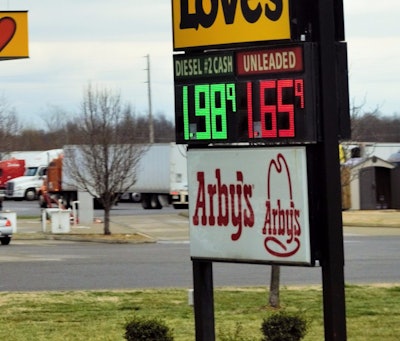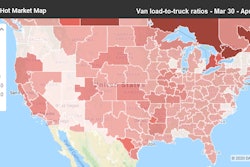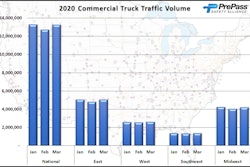 Economists believe the recent trend of low diesel prices will continue into the summer with projects of retail diesel prices near $2 a gallon in the second quarter.
Economists believe the recent trend of low diesel prices will continue into the summer with projects of retail diesel prices near $2 a gallon in the second quarter.A feud over oil prices between Saudi Arabia and Russia that began in early March, combined with a decrease in demand as a result of the global COVID-19 pandemic, has caused crude oil prices around the world to plummet. This has led to lower diesel prices at the pump for truck drivers in recent weeks – a trend that experts say is likely to continue in the coming months.
As of Tuesday afternoon, the West Texas Intermediate price (one of the global benchmarks for crude oil prices), was around $24 a barrel. The other global crude oil benchmark, Brent crude, averaged $32 a barrel in March, down from February’s $56 average, according to the Department of Energy’s Energy Information Administration. EIA, in its monthly Short-Term Energy Outlook report, projects Brent crude prices will average $33 a barrel in 2020, down from an average of $64 a barrel in 2019.
Diesel prices have been on the decline since mid-January, falling by more than 50 cents over the last 13 weeks. EIA reported a national average of $2.55 per gallon of on-highway diesel during the week ending Monday, April 6.
The global spread of the COVID-19 coronavirus also helped propel the decreases through February, said economist Jim Meil of ACT Research. However, he said, the start of a spat between Saudi Arabia and Russia on March 8 was the primary driver of cheaper oil prices.

The disagreement between two of the world’s biggest oil producers began when OPEC+ countries, including Russia and Saudi Arabia, could not reach an agreement to cut oil production to keep crude oil prices in the $50 a barrel range. Russia did not want to cut back on production, so Saudi Arabia decided to ramp up its own oil production to put more pressure on Russia. Meil said WTI oil prices have roughly averaged $50 a barrel for the last three years.
Meil notes that on Feb. 19, WTI crude was at $53 a barrel, which was before the coronavirus began to spread in the U.S., as well as before the Saudi Arabia-Russia disagreement. A month later, on March 20, WTI prices had fallen to around $19.50 a barrel.
“Oil prices have been floating around that pretty much continuously from the 20th of March until [April 3] with a step up to $24,” Meil said.
Sean Hill, an industry economist with EIA, said the steep drop in demand for oil — due to stalling economies caused by coronavirus lockdowns — coupled with “the inconveniently-timed ‘price war’ occurring between the larger global oil producers” has driven oil prices, and in turn retail fuel prices, down.
“Where we are at now, with historically low oil prices, I’m not sure anyone thinks that policy is really sustainable, but we’ll see,” he said. “We’re still fairly early on in this environment as it relates to seeing actual data of impacts and having any idea how long this persists.”
EIA projects U.S. gasoline prices will reach near 20-year lows in the second quarter of 2020. But diesel prices likely won’t fall as far as gasoline, EIA predicts, given a higher demand for diesel with truck drivers still on the road making deliveries. The report projects diesel prices to average around $2 a gallon in the second and third quarters of 2020.
“Somebody [Saudi Arabia or Russia] needs to blink,” said Chris Lee, vice president of marketing at ProMiles. “While I enjoy the low prices, there’s an economic impact to that as well. The U.S. may have the capacity to produce all the oil we need, but at these prices, does it make sense to? At this juncture, it doesn’t make good economic sense to pump oil in the U.S. It makes more economic sense to buy this cheap stuff they’re throwing on the market.”
Lee expects prices will remain low for another week or two, but “I don’t think it’s sustainable beyond that,” he said. “We may all want to see sub-$2 diesel, but the practicality of it isn’t there. The impacts are far greater than the benefits.”
One of those impacts, said Meil, is the effect on the U.S. oil industry, which he said accounts for about 3-5% of business for the U.S. trucking industry. “It’s meaningful, but it’s not dominant like over-the-road freight,” he said. “But in a time of economic duress, you hate to have any sector exposed to difficult times.”
Another area of trucking likely to be impacted, Meil believes, is in new truck sales.
“The drive for fuel efficiency and the advances in technology are some of the crowning achievements of truck OEMs,” he said. “It’s great to see trucks get mileage that was unthinkable even 10 years ago with 8.5 mpg and higher in some cases. But that’s a bigger benefit when diesel is $4 or higher rather than $2.75 and lower. Fuel efficiency is one of the advantages the industry uses to put buyers in trucks, and with lower fuel prices, that advantage goes away.”
Meil said, like much else surrounding the coronavirus outbreak, there’s uncertainty surrounding where the oil market is headed. “Past recessions have been economic or financial,” he said. “This one is caused by a biomedical phenomenon, so we just don’t know.”
Meil, like EIA, predicts the national average for on-highway diesel prices could drop to around $2 a gallon by the summer.











